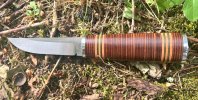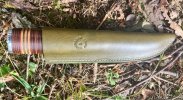Will Power
Gold Member
- Joined
- Jan 18, 2007
- Messages
- 33,514
Ahti and Marttiini make decent everyday puukkot at a fair price. Workmanlike and this is how I regard the national knife, of course there are numerous artisans/smiths of varying skill...some make wonderful items and are priced accordingly, but myself I have no interest in spending a lot on a custom puukko. Pocket-knives...that's another matter 
Not surprisingly, neighbours in Norway, Sweden, Russia produce their own knives but many are influenced by the puukko, and this is homage. As for Mora, well they have their appeal yes...but in the hand they're no match for an inexpensive puukko But I do use an old Mora found in a shed to scrape the crap out of the mower .....
But I do use an old Mora found in a shed to scrape the crap out of the mower .....
Not surprisingly, neighbours in Norway, Sweden, Russia produce their own knives but many are influenced by the puukko, and this is homage. As for Mora, well they have their appeal yes...but in the hand they're no match for an inexpensive puukko












